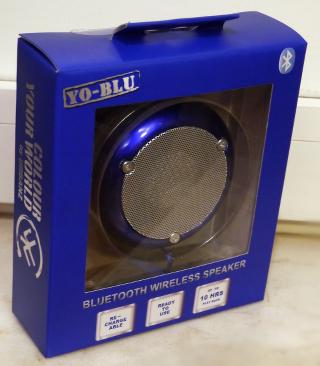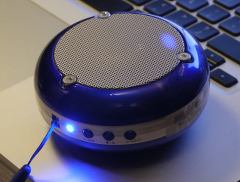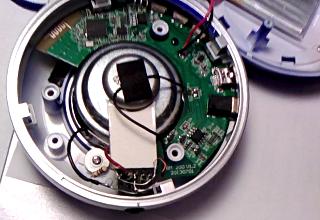Yo-Blu Portable Bluetooth Speaker Review
The low-down: the Yo-Blu by Urbanz is a very practical and well-built wireless speaker that outputs a whole lot of sound with a balanced spectrum and a very decent amount of bass for such a small speaker. Its retail price is somewhat steep, but it can be found at much lower prices if you look around on eBay. If you can buy it for less than €10 like I did, you should not hesitate.

Specifications
- Bluetooth A2DP audio connection
- 3.5mm analogue input
- 3W loudspeaker
- 600 mAh battery, up to 10 hours of playback
- Rechargeable through USB
- Three multi-function buttons: power/pause/play, previous/volume down, next/volume up
- Status LED and audio feedback when powering up/down, Bluetooth pairing, maximum volume
- Dimensions: 9 cm diameter, 4 cm tall
- Weight: 140 g
Build quality and performance
The Yo-Blu is well put together. It has a nice and quite tough blue lacquer finish. There are no obvious gaps or loose parts, and taking it apart reveals a neat layout with a properly designed circuit board. The loudspeaker is pretty high quality. There are three small holes around the speaker that are covered by rubber pads. This appears useless, but I suspect it is a kind of passive resonator to improve bass response.
Getting the speaker set up is easy enough: hold down the power button until the LED starts flashing red and green quickly, then look for “YO-BLU” in the list of discoverable devices. There should be no need to enter codes. The LED will blink with a blue pulse when the speaker has a working audio connection. There is an analog 3.5mm input jack in case you do not have Bluetooth. The speaker powers up automatically when a plug is inserted in this jack.
When I started playing music and test sounds, it became obvious that I bought this for a real bargain. Looking on the web showed a retail price that was easily four times of what I paid. The sound is clear with no distortion even at high volumes, and this thing can go pretty loud. Mind that the speaker's own volume control is separate from the playback device. To adjust the volume, hold down the minus or plus button. When the minimum or maximum volume is reached, the Yo-Blu will beep.

Although it still is a bit of a stretch to talk about ‘bass’ with such a small speaker, the Yo-Blu does not disappoint and produces a quite full sound that one might not expect from its size. With a bit of extra equalisation on the playback device, it is possible to get some extra bass, and thanks to the high quality of the loudspeaker, this will not easily result in distortion. It reaches a very respectable loudness with all volume controls at maximum, although you won't be throwing a big party with it.
Does the Yo-Blu reach its advertised 10-hour playback time? Yes! In fact I believe it easily exceeds 10 hours, but it will depend on how loud the music is played. Recharging the battery when completely empty takes a few hours though. My only true gripe is that the USB port is still an old mini-USB, not the more recent micro-USB. You won't be able to recharge with the same cable as your recent phone or tablet. Maybe this is updated in recent versions, and I still got an old one (which could explain the bargain price), but don't take my word for it.
Another small disadvantage is that the bluetooth audio connection may cause a small delay, although this seems to depend on the playback device. On a tablet I observed audio lagging behind significantly during video playback, but on a MacBook Pro I couldn't notice any lag.
Hacks and tweaks
So, the Yo-Blu is pretty good on its own, but can it be improved? Well, with some very rudimentary adjustments it is possible to get a quite noticeable improvement, especially in bass response. Taking the Yo-Blu apart is easy, you need a 2.5mm Allen key to remove the speaker grille, and a small Phillips or thin flat-head screwdriver for the three screws that are revealed under the grille. Yet, opening the Yo-Blu isn't even necessary for the first simple ‘hack’.
Although the casing is reasonably well-sealed, there are still quite a few gaps and holes where air can leak out, leading to reduced bass response and possibly even ‘puffing’ sounds when playing bass-heavy sounds at high volumes. The fix is pretty mundane: adhesive tape. If you look at the silver ring that surrounds the casing, you'll notice it consists of two parts. Apply tape all around this ring, sealing the gap between the two parts. With crystal-clear tape and some care, this can be done in a pretty much invisible manner.
This leaves the USB port and 3.5mm sockets as the biggest air holes, and you can clearly hear the difference when covering them with your fingers. The pragmatic solution is again to stick a piece of tape over them when you're not charging the Yo-Blu or using headphones, but a more permanent solution would be to open up the casing and seal the sockets from the inside with some kind of compound. Obviously, you should use something non-conductive that also is not too liquid as to get inside the socket and jam it. I have not tried it myself, but hot glue seems like a good choice.

In the next section, I explain that my original intention was to add a 3.5mm output jack, so the Yo-Blu can double as a portable wireless pre-amplifier that can be connected to a larger sound system. This proved pretty easy to do and I was extremely lucky with the dimensions of a 3.5mm jack I had lying around, it fits perfectly in the ring that separates the two halves. All it took was drilling a hole at the right location, prop the jack such that it cannot be pushed inside, and re-solder the wires. The jack has built-in switches, and automatically routes the output back to the loudspeaker when no cable is plugged in. I did add a 100 Ω resistor across signal and ground, to give the amplifier some load when a line cable is connected, and to ensure the cable sees a low impedance at all times. Mind that the Yo-Blu is mono, so you won't be getting a wireless stereo link with this, but I intend to use it for voice only so I don't care.
Background info: why I bought one
I was actually looking for a way to get audio from a tablet to a sound system. Built-in loudspeakers in smartphones and tablets are inevitably bad at producing any appreciable sound at loud volumes, due to their small size. The current solution was a simple wire that plugged into the 3.5mm headphone jack, but this produced way too silent sound on the loudspeakers, even with all the volume sliders and knobs at maximum. When checking the maximum voltage that the tablet could produce, it proved to be around 300 mV, way below the typical 1 Volts for a line-level signal. This is probably thanks to regulations that limit volume on headphones. Moreover, the long wire was clumsy, and bumping the plug could result in loud bangs and crackles on the speakers, due to the amplifier being cranked to the max.
My first idea was to add a tiny amplifier. I quickly gave up on this when I saw the ridiculous prices for small portable amplifiers that were suitable. If anyone is looking for a market opportunity: make a small, simple, rechargeable amplifier with a 3.5mm input and output. Only a power button and rudimentary volume control. With current technology, one can make this thing as small as an AA battery, for cheap. It will sell, believe me.
So my next idea was to use a wireless Bluetooth audio link. This has the potential to produce more output, because these things are often intended to be connected to sound systems and not just headphones. Moreover, I found some pretty cheap ones. Unfortunately, they proved to lack an output amplifier (the PCB had provisions for an amplifier IC, but the cheap-ass Chinese who built the thing left it out). It managed to get to 600 mV, still not enough.
My third idea was to get a Bluetooth loudspeaker instead, and hack it. A loudspeaker certainly needs at least 1 Volt RMS to produce any appreciable sound volume, so I could add a 3.5mm output jack that taps into the amplifier output. Given that I would be hacking and potentially destroying this speaker, I looked for a real cheap one, and I found the Yo-Blu on eBay. But, I was pleasantly surprised about the quality. Eventually I did hack the Yo-Blu (which can produce up to 3.4 Volts on its output, now that's what I'm talking about). By configuring it such that the speaker still works normally when nothing is plugged in the output jack, it is the best of two worlds.
Conclusion
The Yo-Blu is a very good Bluetooth loudspeaker that is easy to use and puts out an impressive sound for its size. It reaches its promised 10 hours playback with ease. If you have the chance to buy this for less than €10 shipping included like I did, it is a bargain. My only gripe is the outdated mini-USB port that should have been a micro-USB, such that it could be recharged with any current cell phone cable.